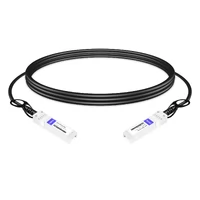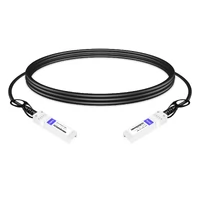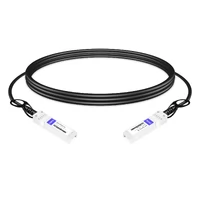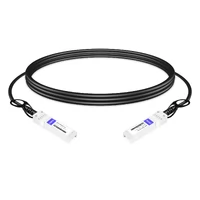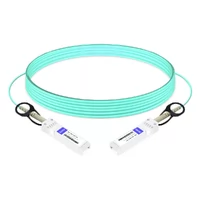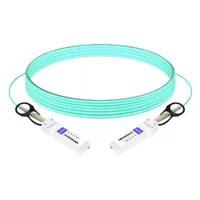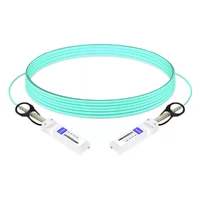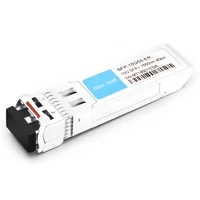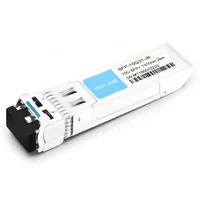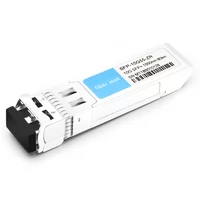In addition to the PCB board or backplane, there are many ways to achieve high-speed connection, which do not necessarily require optical modules. According to different transmission distances, costs, and wiring flexibility requirements, The main connection modes are Direct Attach Cable (DAC), Active Copper Cable (ACC), Active Optical Cable (AOC), and Optical Transceiver Module (Optical Module) connect several ways. The following table is a comparison of the main features of several high-speed connections.
| Connection method | Price | Connection distance | Weight | Flexibility | Power consumption | Reliability | Main application scenarios |
|---|---|---|---|---|---|---|---|
| DAC/ACC | ☆ | ☆ | ☆☆ | ☆☆ | ☆☆☆☆ | ☆☆☆☆ | In-cabinet or adjacent cabinets; server-switch connection |
| AOC | ☆☆☆ | ☆☆ | ☆☆☆☆ | ☆☆☆ | ☆☆ | ☆☆☆ | Within a cabinet or in the same row of cabinets; server-switch connection |
| Multi-mode optical module | ☆☆ | ☆☆ | ☆☆☆☆ | ☆☆☆☆ | ☆☆ | ☆☆ | In the same row of cabinets or in the same server room; switch-switch connection |
| Single-mode optical module | ☆ | ☆☆☆☆ | ☆☆☆☆ | ☆☆☆☆ | ☆ | ☆☆ | Within or across server rooms; switch-switch connection |
DAC (Direct Attach Cable), also known as Passive Copper Cable, uses conductive copper wires to connect two ends directly. DAC internal is generally a shielded Twinax structure, commonly used wire 24AWG, 26AWG, 28AWG, 30AWG, 32AWG, etc. The smaller the AWG value, the thicker the wire, while the loss is also smaller. So long-distance DACs are usually made of wire with a smaller AWG value, but thicker wire is less easy to bend and heavier.
DACs have no passive components inside, so they have low power consumption, wide temperature range, high reliability, and are generally cheaper. Therefore they are widely used for 10G interface connections (such as 10Gbps SFP+ interfaces or 4*10Gbps QSFP+ interfaces).
Since copper wires are lossy, they cannot be made too long to ensure reliable transmission of high-speed signals. So the length of DAC cables in data centers is usually around a few meters (usually transmitting 10Gbps up to 7 meters, 25Gbps up to 5 meters, and 56Gbps PAM-4 signals up to about 3 meters).
As the rate of the data center server interface transitions from a single 10G/25Gbps NRZ to a 56Gbps PAM-4 signal, the transmission distance of DAC is greatly reduced. So in data center applications above 25Gbps, DAC will be gradually replaced by ACC cable or AOC cable.
The figure below shows a comparison of the insertion loss of several dual coaxial cables.
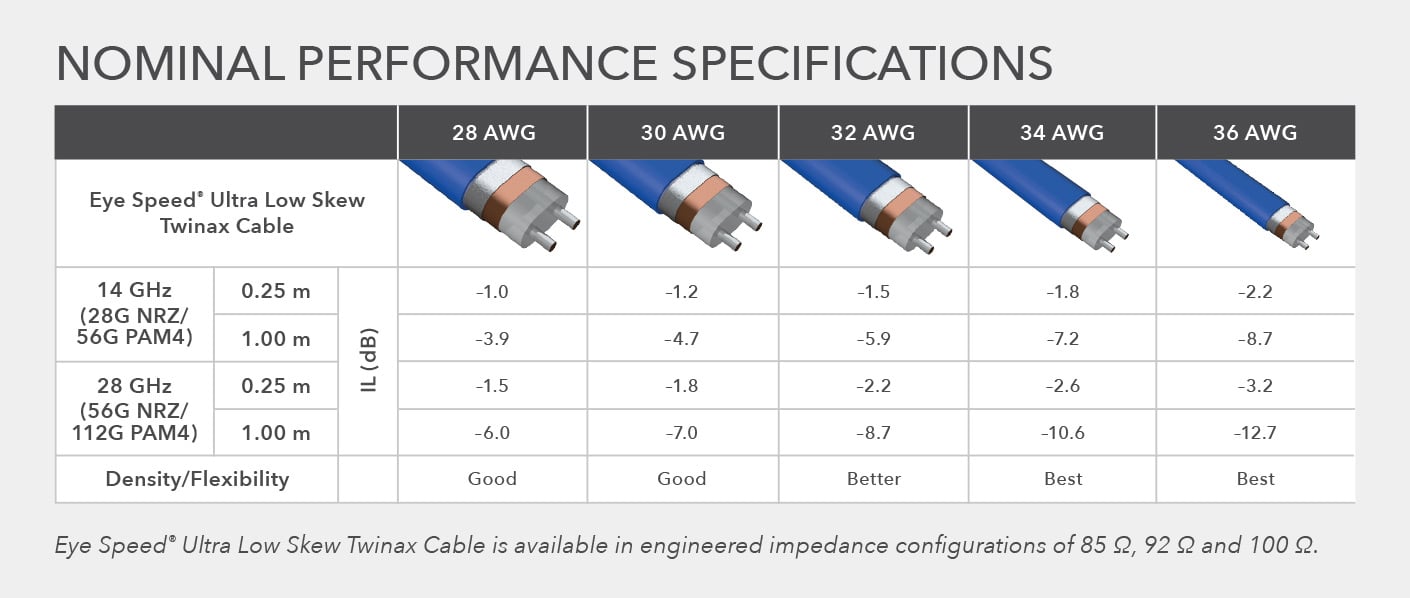
ACC (Active Copper Cable) refers to active copper cable, whose connection medium is the same as that of DAC. However, an active signal driver or equalizer chip is added inside the cable. These active chips can compensate for part of the loss caused by copper transmission, so they can transmit 2 to 3 times farther than DAC.
ACC cables have increased power consumption and cost compared to DAC cables, and their performance depends in large part on the bandwidth, gain, and equalization capabilities of their internal active chips. For ACC cables, the active chip used may be divided into Redriver and Retimer.
Redriver is a pure analog chip, mainly for signal equalization and amplification, only to enhance the signal or the high-frequency components, but it will accumulate jitter and noise.
Retimer will clock recovery, resample the signal and send it out, which can get better signal improvement, but the price and power consumption will be higher.
The following figure shows the comparison of DAC cable and ACC cable.
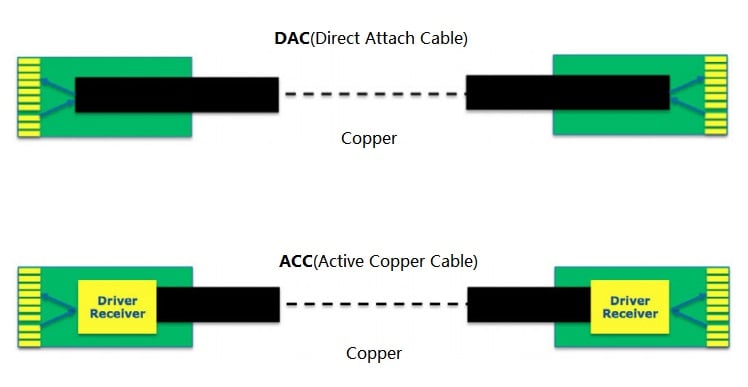
AOC is Active Optical Cable, and the difference between the DAC and ACC introduced above is that it has a special internal optical transceiver chip to convert the electrical signal into an optical signal, the real signal transmission is through the optical fiber.
The transmission distance of AOC can be farther because the loss of optical fiber for the signal is much lower than copper wire. AOC generally uses multi-mode optical fiber and VCSEL light source, the transmission distance is from meters to 100 meters.
AOC’s optical transceiver and fiber optic interface are sealed into one, not pluggable. The exposed metal connector is the same as the normal copper cable, so there is no need to clean the optical fiber connection. This makes it look and use like a normal copper cable. Because the AOC is internally transmitted by optical fiber, it is light in weight, far in transmission distance, easy to wire, and insensitive to electromagnetic radiation. However, because of the corresponding built-in optical transceiver devices, the price will be higher than DAC and ACC. AOC has a very wide range of applications in data centers for high-speed rates and short-distance connections.
Optical Transceiver Modules, or optical modules for short, are a type of optical connectivity technology that is used on a large scale in both data centers and telecommunications.
The main difference between the optical transceiver module and AOC is that the optical transceiver device and optical fiber are separated into different components: the optical transceiver module is used to convert electrical signals to optical signals, while the optical fiber is used to connect between optical transceiver modules, and the optical fiber and optical modules can be connected flexibly through special interfaces (such as SC, LC, MPO, etc.).
The biggest advantage of this connection method compared to AOC is that it can realize flexible connections between the optical modules and optical fiber according to different application scenarios. For example, if the optical module can support a 500m transmission distance, the user can use 100m optical fiber or 300m optical fiber according to the actual connection distance. In addition, in many large data centers and telecom rooms fiber optic resources are pre-arranged through a fiber optic distribution frame during the construction phase, once the corresponding optical module is damaged, the optical module can be timely plugged in and replaced, which greatly facilitates the operation and maintenance work.
The following figure shows the comparison of the AOC and optical module.
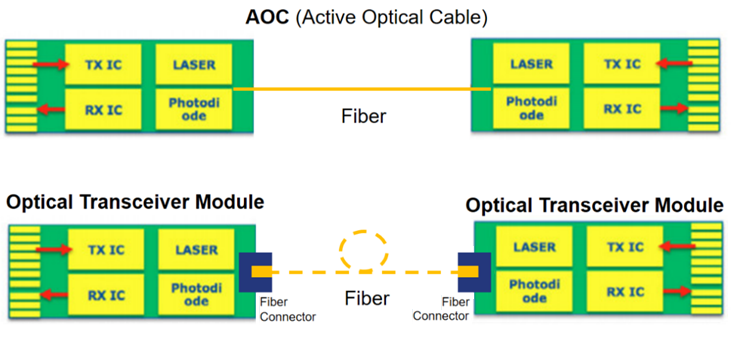
Table of Contents
ToggleRelated Products:
-
 SFP-10G-AC5M 5m (16ft) 10G SFP+ to SFP+ Active Direct Attach Copper Cable
$45.00
SFP-10G-AC5M 5m (16ft) 10G SFP+ to SFP+ Active Direct Attach Copper Cable
$45.00
-
 SFP-10G-AC10M 10m (33ft) 10G SFP+ to SFP+ Active Direct Attach Copper Cable
$55.00
SFP-10G-AC10M 10m (33ft) 10G SFP+ to SFP+ Active Direct Attach Copper Cable
$55.00
-
 SFP-10G-PC1M 1m (3ft) 10G SFP+ to SFP+ Passive Direct Attach Copper Cable
$8.00
SFP-10G-PC1M 1m (3ft) 10G SFP+ to SFP+ Passive Direct Attach Copper Cable
$8.00
-
 SFP-10G-AC1M 1m (3ft) 10G SFP+ to SFP+ Active Direct Attach Copper Cable
$25.00
SFP-10G-AC1M 1m (3ft) 10G SFP+ to SFP+ Active Direct Attach Copper Cable
$25.00
-
 SFP-10G-AOC-3M 3m (10ft) 10G SFP+ to SFP+ Active Optical Cable
$22.00
SFP-10G-AOC-3M 3m (10ft) 10G SFP+ to SFP+ Active Optical Cable
$22.00
-
 SFP-10G-AOC-20M 20m (66ft) 10G SFP+ to SFP+ Active Optical Cable
$31.00
SFP-10G-AOC-20M 20m (66ft) 10G SFP+ to SFP+ Active Optical Cable
$31.00
-
 SFP-10G-AOC-30M 30m (98ft) 10G SFP+ to SFP+ Active Optical Cable
$36.00
SFP-10G-AOC-30M 30m (98ft) 10G SFP+ to SFP+ Active Optical Cable
$36.00
-
 SFP-10G55-ER 10G SFP+ ER 1550nm 40km LC SMF DDM Transceiver Module
$80.00
SFP-10G55-ER 10G SFP+ ER 1550nm 40km LC SMF DDM Transceiver Module
$80.00
-
 SFP-10G31-IR 10G SFP+ IR 1310nm 2km LC SMF DDM Transceiver Module
$15.00
SFP-10G31-IR 10G SFP+ IR 1310nm 2km LC SMF DDM Transceiver Module
$15.00
-
 SFP-10G55-ZR 10G SFP+ ZR 1550nm 80km LC SMF DDM Transceiver Module
$150.00
SFP-10G55-ZR 10G SFP+ ZR 1550nm 80km LC SMF DDM Transceiver Module
$150.00

